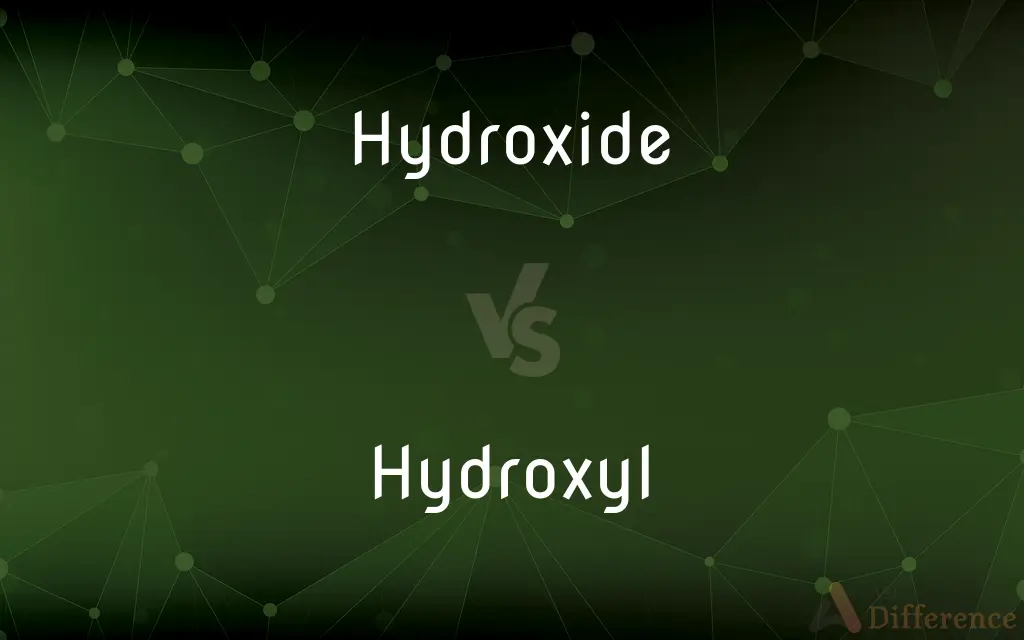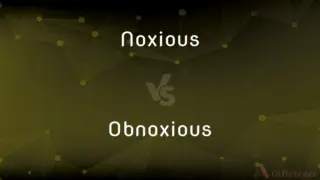Hydroxide vs. Hydroxyl — What's the Difference?
By Tayyaba Rehman — Updated on November 3, 2023
Hydroxide is a negatively charged ion (OH−) consisting of oxygen and hydrogen, whereas hydroxyl is a neutral chemical group (–OH) comprising one oxygen and one hydrogen atom.

Difference Between Hydroxide and Hydroxyl
Table of Contents
ADVERTISEMENT
Key Differences
Hydroxide is an anion (negative ion) consisting of one oxygen and one hydrogen atom carrying a negative charge, denoted as OH−. It is found in many bases and is crucial to the pH levels of solutions. Hydroxyl groups, on the other hand, refer to the –OH part of organic molecules without an extra electron, making them neutral. This group is covalently bonded to carbon atoms within organic compounds, playing a vital role in organic chemistry.
Hydroxide ions are fundamental constituents of hydroxide compounds, such as sodium hydroxide (NaOH), which are typically strong bases. These ions are responsible for the basicity of compounds in water. Hydroxyl groups are not found alone but as a part of larger molecules, such as alcohols, where they affect the molecule's solubility and reactivity due to their polar nature.
In aqueous solution, hydroxide ions increase the pH and can react with hydrogen ions to form water. This ability to neutralize acids is a defining property of bases. Hydroxyl groups, however, are more about the chemical reactivity within organic molecules, like in the formation of hydrogen bonds, which influences boiling points and solubility of the molecules they are part of.
Hydroxide plays a crucial role in acid-base chemistry and is used in various applications, from soaps to drain cleaners. Hydroxyl groups are essential in the structure and function of many organic compounds, including sugars and alcohols, where they participate in the formation of molecules like carbohydrates and contribute to the properties of these compounds.
The presence of hydroxide ions in a solution is often measured to determine the solution’s alkalinity. In contrast, the presence of hydroxyl groups within a molecule is a determining factor for classifying organic compounds into different types, such as alcohols, phenols, and carboxylic acids.
ADVERTISEMENT
Comparison Chart
Charge
Carries a negative charge.
No charge, it’s a neutral group.
Existence in Solutions
Exists freely in solutions as ions.
Does not exist freely; part of molecules.
Role in Acidity/Basicity
Contributes to basicity when in solution.
Does not directly affect pH of solutions.
Bonding
Ionic in hydroxide salts.
Covalent bonding in organic compounds.
Representation in Chemical Formulas
Represented by OH−.
Represented by –OH attached to a carbon.
Compare with Definitions
Hydroxide
Present in basic solutions and compounds.
Lime water is basic because it contains calcium hydroxide.
Hydroxyl
A functional group in organic chemistry.
Ethanol contains a hydroxyl group making it an alcohol.
Hydroxide
Reacts with acids to form water and a salt.
Hydroxide ions react with hydrochloric acid to produce water.
Hydroxyl
Consists of oxygen and hydrogen atoms.
The hydroxyl group in sugars contributes to their solubility in water.
Hydroxide
A negatively charged ion of oxygen and hydrogen.
Sodium hydroxide (NaOH) is a commonly used hydroxide in industry.
Hydroxyl
Participates in hydrogen bonding.
Hydroxyl groups form hydrogen bonds, affecting the molecule's physical properties.
Hydroxide
Hydroxide is a diatomic anion with chemical formula OH−. It consists of an oxygen and hydrogen atom held together by a single covalent bond, and carries a negative electric charge.
Hydroxyl
Affects the boiling point of compounds.
The presence of multiple hydroxyl groups raises the boiling point of glycerol.
Hydroxide
A chemical compound, especially an ionic compound, containing a hydroxyl group.
Hydroxyl
Covalently bonded to carbon in molecules.
The hydroxyl groups are responsible for the properties of phenol.
Hydroxide
(chemistry) An univalent anion (OH-) based on the hydroxyl functional group.
Hydroxyl
The univalent group OH, a characteristic component of bases, certain acids, phenols, alcohols, carboxylic and sulfonic acids, and amphoteric compounds.
Hydroxide
Any substance containing such an anion.
Hydroxyl
(chemistry) A univalent radical or functional group (–OH) in organic chemistry; present in alcohols, phenols, carboxylic acids and certain other classes of compounds.
Hydroxide
A hydrate; a substance containing hydrogen and oxygen, made by combining water with an oxide, and yielding water by elimination. The hydroxides are regarded as compounds of hydroxyl, united usually with basic element or radical; as, calcium hydroxide ethyl hydroxide.
Hydroxyl
A compound radical, or unsaturated group, HO, consisting of one atom of hydrogen and one of oxygen. It is a characteristic part of the hydrates, the alcohols, the oxygen acids, etc.
Hydroxide
A compound of an oxide with water
Hydroxyl
The monovalent group -OH in such compounds as bases and some acids and alcohols
Hydroxide
A chemical compound containing the hydroxyl group
Hydroxide
Measured in solutions to determine alkalinity.
The concentration of hydroxide ions indicates the solution's pH level.
Hydroxide
Found in many cleaning products.
Household bleach contains sodium hydroxide as an active ingredient.
Common Curiosities
What does a hydroxyl group consist of?
A hydroxyl group consists of an oxygen and a hydrogen atom, bonded together.
Can hydroxyl groups form hydrogen bonds?
Yes, hydroxyl groups can form hydrogen bonds with other molecules.
Can hydroxide form salts?
Yes, hydroxides can form salts when they react with acids.
Are hydroxyl groups charged?
No, hydroxyl groups are neutral.
What type of compounds contain hydroxyl groups?
Alcohols, phenols, and carboxylic acids contain hydroxyl groups.
Can hydroxide be found in nature?
Yes, hydroxide ions are naturally present in water and in various minerals.
What is a hydroxide ion?
A hydroxide ion (OH−) is a negatively charged molecule made up of oxygen and hydrogen.
Where are hydroxides found?
Hydroxides can be found in bases like sodium hydroxide.
Is hydroxide the same as a hydroxyl group?
No, hydroxide is an ion with a charge, whereas a hydroxyl group is neutral.
What's the significance of hydroxyl in organic chemistry?
Hydroxyl groups are important in determining the properties and reactions of organic molecules.
How are hydroxides used in everyday products?
Hydroxides are commonly used in cleaning agents and soaps.
What role does hydroxide play in pH?
Hydroxide ions increase the pH level of solutions, making them more basic.
Are hydroxyl groups reactive?
Hydroxyl groups are reactive and are involved in many chemical reactions.
What determines the basic strength of hydroxides?
The basic strength of hydroxides is determined by the ease with which they donate their hydroxide ion.
Do hydroxyl groups affect solubility?
Yes, hydroxyl groups can increase the solubility of organic compounds in water.
Share Your Discovery

Previous Comparison
Socialise vs. Socialize
Next Comparison
Noxious vs. ObnoxiousAuthor Spotlight
Written by
Tayyaba RehmanTayyaba Rehman is a distinguished writer, currently serving as a primary contributor to askdifference.com. As a researcher in semantics and etymology, Tayyaba's passion for the complexity of languages and their distinctions has found a perfect home on the platform. Tayyaba delves into the intricacies of language, distinguishing between commonly confused words and phrases, thereby providing clarity for readers worldwide.















































